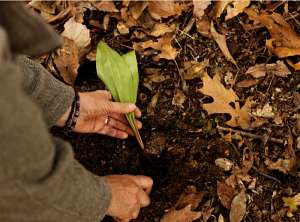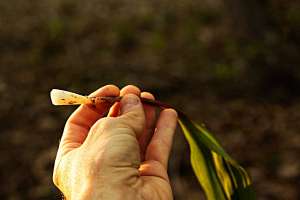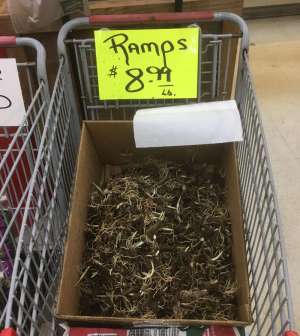Where to find
Ramps occur in Eastern North America from Georgia to Canada. They’re easily recognized by their 1, 2, or 3 broad leaves measuring 1 to 3 1/2 inches wide and 4 to 12 inches long.
There are a couple of varieties:
Allium tricoccum var. tricoccum: These have wider leaves and red stems.
Allium tricoccum var. burdickii: Also known as narrow-leaf or white ramps.
White-stemmed narrow-leaf ramps (Allium tricoccum var. burdickii) tend to have a milder flavor than the red-stemmed variety. They also have smaller leaves (up to 1 1/2 inches wide), as well as smaller bulbs.
Ramp leaves appear from March to April and last until around mid-May to June depending on the local climate. As temperatures get warmer, the leaves will turn yellow and die.
Look for them underneath dense deciduous forest canopy in soil that’s rich with organic matter.
In general, Narrow-leaf ramps are more likely to be found in more well-drained, dryer woods, while red-stemmed ramps prefer damper soil.
That being said, it’s not uncommon to find both varieties growing side-by-side.
There are some dangerous look-alikes so be sure the plants you pick smell like onion or garlic.
Do not pick the dangerous Lily of the Valley (Convallaria majalis) or False hellebore (Veratrum genus) by mistake.
Again, make sure they smell like onion or garlic. If you’re unsure, let a knowledgeable forager confirm your find or just pass on picking.
It may also be helpful to consult multiple references for more positive identification.
Sustainability
Unfortunately for ramps, they’re super-trendy these days. Chefs, foodies, and other ramp-lovers flock to the mountains by the thousands for a chance to bask in their gourmet-ness.
“Ramp feeds,” known as ramp festivals now, have been taking a toll on ramp populations for years and the added pressure of their recent popularity has really put a hurting on their numbers.
The implications affect conservationists and foodies alike. Cindy and I are conservationists first and foragers second. What this means for us is that ramping is not only unsustainable, but it gets more arduous each year as we climb higher and longer to find undiscovered ramp patches.
Traditionally, the Cherokee dug, and still dig, ramps by leaving the roots. This is done by cutting off the bottom of the bulb with a knife while it’s still in the ground (more on the how-to below).

How to harvest
If you plan on digging ramps on public land, you’ll want to look into whether local regulations restrict harvest amounts, where harvesting is permitted, etc.
In West Virginia where we live, as of 2020, the Forest Service allows harvesting for personal use only – anyone can dig up to two gallons of ramps at a time. That’s about the volume of a plastic grocery bag or, according to the USFS, about 180 plants with leaves and roots.
And digging is no longer permitted in some parks due to declining ramp populations, so please be aware of local rules and conservation issues.
Here are a few things you’ll need for harvesting ramps:
-
Time This one is really important. It’s way too easy to run up to the ramp patch after work with good intentions of sustainbly digging ramps. You get to the trailhead at 5:30pm and it’s 6pm by the time you’re digging ramps. The sun’s about to slip behind the mountains and you’re in a sudden hurry to get your ramps and get out of there. So you abandon your plan and jerk as many roots out of the ground as you can before running out. DON’T DO IT!
Sustainably harvesting takes more time, so you really need to make allowance for it. Plus it’s a lot more fun to have a leisurely walk into the woods, not worrying about racing the waning light. If you can’t give yourself the time to do it, please consider taking only greens and leaving the bulbs undisturbed. You won’t need nearly as much time if you only harvest leaves!
-
Sharp hunting knife Make sure it’s sharp! A dull knife will do more harm than good – you’ll end up mutilating the bulb so it’s not useable as food and not viable as a plant. You may even want to touch up the blade as you dig, since the grit of the dirt will take your edge. You’ll also want to make sure the blade is at least three or four inches so you can easily reach the root without disturbing the soil.
If you insist on digging the root, use a hori hori knife to minimize impact.
-
Backpack or shoulder bag I usually put a few plastic grocery bags in a backpack and then load a bag or two with ramps before putting them in my pack, which helps keeps the dirt out of the pack.
The most sustainable way to harvest ramps is to cut only one leaf, leaving the bulb and second leaf to continue growing. This is least impactful on the soil, the plant, and the colony as a whole.
The leaves, in my opinion are the best part, anyway, and taking only leaves is the best way to ensure the colony will remain viable.

If you insist on taking bulbs, please dig sustainably with a knife: Simply insert your knife into the dirt at an angle and slice off a third or so of the root, leaving it in the ground to re-grow. Then pull the rest of the plant out by its stems.
It will take a little practice to get a feel for where to put the knife. You can also gently pull back the dirt from around the bulb so you can see where you’re cutting. If you do this, make sure to pull back just enough dirt to expose a little bit of the bulb and re-cover the roots after cutting.
That’s all there is to digging. Please be judicious and don’t take any more than you will use.
I find that when I overzealously harvest, it makes more work for me in the long run, because some ramps will inevitably go bad before I can get to them. There’s not much more disgusting than the smell of past-their-prime ramps. And a few ramps go a long way so there’s no need to stockpile them.
Even though we practice sustainable harvest, I’m afraid the ever-inceasing demand will eclipse the slow procreation.
According to North Carolina Extension Horticultural Specialist Jeanine M. Davis, ramps can be transplanted and cultivated from seed in climates where ramps don’t normally grow. Apparently, it takes some effort to germinate seeds when climes are warmer than ideal, but it can be done.
And once a good patch is established, it requires little maintenance. Jeanine recommends the book Having Your Ramps and Eating Them Too by the “Johnny Appleseed of Ramps” for more info on cultivating ramps. Unfortunately this book is no longer in print.
We’ve been growing our own for a while. Our homestead is located in the ramp belt now, but our previous place was outside of ramp habitat. When we lived there, our planted ramps didn’t spread because conditions weren’t ideal.
They did grow, though, and as long as we continued to plant new ramps, we always had a steady supply right outside of our door.
Where to buy
If you’re lucky enough to live in an area where ramps are abundant, it’s not uncommon to see them in the grocery store when they’re in season. Where we live, they’re also common in seasonal dishes served at local restaurants.

How to store
Ramps are only in season for a month or so, but, for us, getting them is only half the problem. I usually come back from a good ramping trip with enough for us to eat fresh before they go bad with a little extra to keep for eating later (I rarely go digging more than once a season unless I come home with a particularly light harvest).
Both leaves and bulbs can be eaten and both are delicious. They’re best used fresh, but both can be put away for eating later in the year.
The easiest way to store ramp bulbs is by freezing: Simply cut off the greens, clean the dirt off the bulbs and cut off the roots (if your ramps still have roots). Then spread the bulbs out on a sheet pan or waxed paper so they are not touching and freeze. This prevents them from sticking together.
Once they’re frozen, put them in jars or plastic containers, seal tightly and put in the freezer for up to six months. You can also wrap them individually in wax paper and store frozen in sealed jars. They can also be pickled but we don’t usually bother.
The greens won’t last long fresh and deteriorate when frozen. They can be dried, but they lose a lot of their flavor. We’ve found the best way to preserve them is by making ramp compound butter (see recipe below). A close second is ramp pesto. Either can be stored in the refrigerator in the short term or frozen for use later.
For short term storage put ramps in the refrigerator as soon as possible. They should be stored uncleaned. If a refrigerator is not immediately available ramps can be kept with the bulbs submerged in a bucket of water and placed in a cool shaded area.
The leaves will start to wilt in the refrigerator after 4 days or so and in the bucket after a day or so depending on temperature.
How to cook
Ramp bulbs and leaves can be diced and used just as you would use onions, green onions, leeks, chives and garlic, but they are much more potent. They pair well with the following:
-
pasta
-
eggs
-
chanterelle mushrooms and other wild mushrooms
-
potatoes
-
stir fried and raw greens
-
pork
Some folks like to eat ramps raw. I like a little chopped up in a salad, but ramps as a cooked vegetable are a lot more fun. My favorite way to eat them is mixed into venison burgers or in ramp and white cheddar soup. And it’s hard to beat ramps and eggs for breakfast.
 A few years back, Cindy came across this sweet little book from West Virginia called Mom & Ramps Forever! by Barbara Beury McCallum. There’s some fun anecdotal history on ramps in there. It’s also a collection of old timey recipes and stand-bys like pickled ramps and ramp champ – mashed potatoes with ramps. Here’s one of the recipes… quick and easy and sounds tasty:
A few years back, Cindy came across this sweet little book from West Virginia called Mom & Ramps Forever! by Barbara Beury McCallum. There’s some fun anecdotal history on ramps in there. It’s also a collection of old timey recipes and stand-bys like pickled ramps and ramp champ – mashed potatoes with ramps. Here’s one of the recipes… quick and easy and sounds tasty:
Ramps With Watercress
“Fry some bacon until crisp, remove the bacon then drain off part of the bacon drippings. Put washed cress into the pan with the water that clings to it. Cook covered, until tender. Garnish with crumpled bacon, finely chopped ramps, and some chopped hard cooked eggs.”
Unfortunately, Mom & Ramps Forever! is out of print, but it’s a nice one for the collection if you can find it.






![Air gun 101: The differences between .177 & .22 – Which jobs they do best ? [Infographic]](https://airgunmaniac.com/wp-content/uploads/2020/09/g44-218x150.jpg)








































